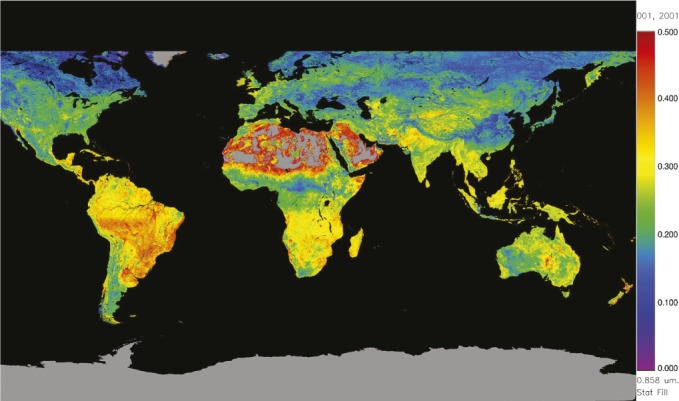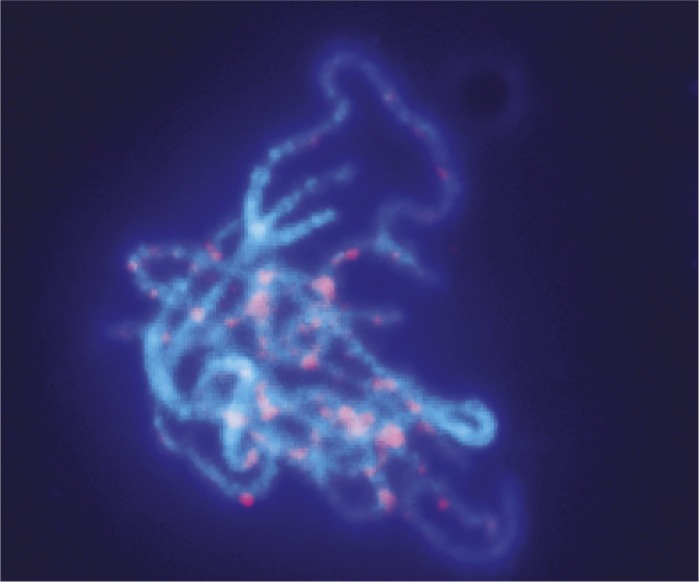No-till farming and climate change

Global albedo map with high albedo shown in red. Image courtesy of NASA.
Untilled croplands exhibit increased albedo and carbon sequestration, characteristics that could partially mitigate climate change, yet no-till management has not been widely adopted in Europe. To examine the potential effects of full conversion to no-till management on Europe’s climate, Edouard Davin et al. (pp. 9757–9761) measured the difference in albedo on tilled and untilled farmland and used the results to model potential temperature changes. The average albedo of an experimental wheat field in Southern France during the summer increased 50% under no-till management. Using a regional climate model, the authors predicted that a higher albedo would cool temperatures overall, and that the cooling effect may be as great as 2 °C during extremely hot summer days. According to the authors, the results suggest that no-till management may prove effective in mitigating temperature extremes on a local scale. Such extremes, though rare, have a disproportionate impact on ecosystems. Further, adoption of no-till practices may have a large mitigation potential in Europe because it is one of the most densely farmed regions in the world and no-till practices have not yet been widely implemented, according to the authors. — J.P.J.
Water resources efficiency in China’s agricultural trade

Longsheng rice terraces in southeastern China. Image courtesy of Wikimedia Commons/Severin.stalder.
China’s demand for water due to rapid development and high irrigation use prompts an assessment of water use efficiency in agricultural trade. Carole Dalin et al. (pp. 9774–9779) studied aspects of China’s virtual water trade, which refers to the water required to produce goods traded domestically or internationally. The authors used hydrological and economic models to estimate the amounts of rainfall and irrigation water resources transferred as food exports or imports between China’s provinces, which experience variation in rainfall and groundwater availability. The authors found that interprovince food trade is efficient in terms of rainwater, but inefficient in terms of irrigation water, because dry, groundwater-dependent provinces export food to wet, rainfall-rich provinces. Examining international trade, the authors found that China’s soy imports bring virtual water into the country and afford the soy trade significant water efficiency. The authors identify regions such as dry northern provinces that may benefit from improving agricultural water-use efficiency. The results may inform policy decisions pertaining to water-use efficiency and agricultural trade, according to the authors. — P.G.
Synaptic vesicle capacity and Parkinson disease
Aberrant dopamine signaling underlies Parkinson disease (PD). Previous attempts to enhance dopamine transmission have encountered side effects and loss of effectiveness over time. To investigate whether increasing the capacity of sacks of neurotransmitters called synaptic vesicles would increase dopamine release without the attendant problems, Kelly Lohr et al. (pp. 9977–9982) overexpressed the vesicular monoamine transporter 2 (VMAT2) protein in mouse striatum, a brain region showing marked dopamine loss in patients. VMAT2-overexpressing mice (VMAT2-HI) displayed increased uptake of dopamine into synaptic vesicles and increased total synaptic vesicle capacity for dopamine, with no alterations in the structural integrity of the nerve cell terminal. Further, VMAT2-HI mice displayed increased dopamine release and locomotion, and decreased anxiety-like and depressive-like behaviors, compared with wild-type littermates. Previous studies with other neurotransmitter transporters have found that increased transporter expression was compensated by a decreased number of released vesicles, with no net change in neurotransmission, but VMAT2-HI mice did not follow this pattern. When treated with a neurotoxicant used to create a mouse model of PD, VMAT2-HI mice showed significant neuroprotection, compared with wild-type mice. According to the authors, the increase in dopamine release in the VMAT2-HI mice, coupled with the neuroprotection, suggests that treatments targeting vesicular packaging might help combat PD. — L.G.
Fathers’ brain responses to parenting experiences

Father and child. Image courtesy of Wikimedia Commons/Andrés Nieto Porras
Previous studies have examined mothers’ brain responses to caring for infants, yet few researchers have investigated whether differences between maternal and paternal brain responses are related to the sex of the primary caregiver. Eyal Abraham et al. (pp. 9792–9797) monitored the brain responses of 89 first-time parents to interactions with their child. Twenty primary-caregiving heterosexual mothers, 21 secondary-caregiving heterosexual fathers, and 48 primary-caregiving homosexual fathers raising infants within a partnered relationship participated in the study. The authors found that parenting activities integrated the brain’s emotional-processing and mentalizing networks, which create emotional salience in childcare and help attune parents to infants’ states. Primary-caregiving mothers displayed increased activation of emotion-processing structures, particularly the amygdala, and secondary-caregiving fathers displayed increased activation of socio-cognitive circuits, particularly the superior temporal sulcus. Primary-caregiving fathers showed high activation of both the amygdala and the superior temporal sulcus. The degree of connectivity between the two structures in all fathers correlated with the amount of time spent in direct childcare. Primary-caregiving fathers might functionally integrate the emotion processing and mentalizing networks, the authors suggest. The results suggest a caregiving network in the brain, activated in both women and men, according to the authors. — P.G.
Minimizing errors in detection of genomic variation

Arabidopsis meiotic prophase I chromosomes (blue) with foci of the RAD51 proteins (red), which mark sites of recombination.
DNA polymorphisms can serve as molecular markers for genetic studies of human traits and diseases. Although researchers can detect and analyze DNA polymorphisms using short reads from high-throughput sequencing, the presence of repetitive sequences and structural variants can lead to false positives during the identification of polymorphic alleles. Focusing on single nucleotide polymorphisms, (SNPs), Ji Qi et al. (pp. 10007–10012) examined potential detection errors caused by structural variants and describe a strategy for minimizing false positives. By comparing resequenced and reference genomes, the authors’ approach identifies sequencing errors, small insertions or deletions known as indels, and structural variants, including large reciprocal indels and copy number variants. Applying the approach, the authors offer an alternative interpretation of recently published resequencing data from Arabidopsis meiotic products and human DNA sequences, including the number and type of recombination events, to illustrate the potential for errors in SNP detection. The findings demonstrate the need to examine structural variants when using short reads to identify DNA markers for genetic analyses, according to the authors. — T.J.


